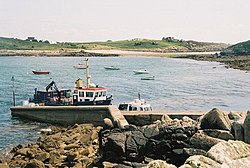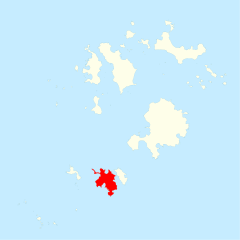St Agnes, Isles of Scilly
| St Agnes Cornish: Aganas | |
 St Agnes | |
|---|---|
| Location | |
| Grid reference: | SV881430 |
| Data | |
| Population: | 73 |
St Agnes is the southernmost populated island of the Isles of Scilly, Cornwall.
St Agnes joins the island of Gugh by a tombolo, a kind of sandbar, called the Gugh Bar, which is exposed only at low tide. The two islands together have the smallest population of the Scilly archipelago, with 73 residents recorded in the 2001 census, and a landmass of 366 acres.
There is today one church: St Agnes' Church (Church of England).

In earlier times many men from St Agnes earned a living as pilots, guiding transatlantic liners and other vessels through the English Channel. Now the mainstay of the economy is tourism, together with some bulb farming. Accommodation is limited though, and St Agnes is the only populated island in the Isles of Scilly which has no hotel. However, it has a few B&Bs and self-catering cottages, a campsite, a small post office general store and a gift shop. It also has a pub (the Turk's Head) and a cafe, although these are closed in the winter.
The main population centre is in the north and middle of the island. The southern end of the island is covered by the heather moorland of Wingletang Down.
Lighthouse
The island's most notable landmark is its lighthouse, which has been converted into living accommodation and the tower no longer contains a light. It was built in 1680 by Trinity House and was coal fired until 1790, when it was converted to oil fired, with copper lamps and 21 revolving reflectors. A plaque records original construction by Captains Hugh Hill and Simon Bayly, builders of the 1676 Lowestoft lighthouse.
The St Agnes lighthouse was the second to be built in Cornwall (after the Lizard lighthouse of 1619). It stands 74' above the ground, and 138' above mean high water. It was superseded in 1911 by the Peninnis Lighthouse. St Agnes lighthouse now serves simply as a daymark for shipping. Peninnis lighthouse is a 56-foot-tall black and white steel lattice tower situated on the southern extremity of St Mary's island. The range was reduced from 17Nm to 9Nm under the Trinity House 2010 Aids to Navigation review. The light source employed is now LED.[1][2]
Other sights

Other landmarks include a standing stone known as the Nag's Head (probably a natural formation) and the so-called "Troytown Maze" a pebble maze thought to be of mediæval date. In 1707, many of the sailors who had drowned in the great naval disaster off the Isles of Scilly were reputedly buried on the St Agnes playing field.[3]
Sporting and social life
Friday evenings in the summer (end of April until start of October) see men's domestic Cornish Pilot Gig racing on Scilly, with the ladies' race on Wednesday. After the race, supporters fill the Turk's Head to discuss the race and to socialise. The pub is always open through the summer, but during the winter it is only open on Wednesdays for a quiz, and one other night.
Natural history
Over one third of the area of St Agnes is designated as Sites of Special Scientific Interest (SSSI).
- Wingletang Down in the south of the island is noted for its heath, dune grassland and rocky coast and is the only site in Great Britain where the fern, least adder's–tongue (Ophioglossum lusitanicum) grows. Other rare plants include the orchid, autumn lady’s–tresses (Spiranthes spiralis) and early meadow-grass (Poa infirma). The only freshwater pools on St Agnes are Big Pool and Little Pool in the north-west of the island which are part of the Big Pool and Browarth Point SSSI. The vegetation has some brackish influence because of occasional influx of the sea during winter storms with rushes such as saltmarsh rush (Juncus gerardi) and sea club–rush (Scirpus maritimus). The surrounding grassland, which is also a cricket pitch, is notable for the clovers amongst its flora including western clover (Trifolium occidentale), suffocated clover (Trifolium suffocatum) and subterranean clover (Trifolium subterraneum). Other plants include adder’s-tongue (Ophioglossum vulgatum) and small adder’s-tongue(Ophioglossum azoricum).[4][5]
Vagrant birds
St Agnes is a favourite island of visiting birdwatchers, particularly during the ″Scilly season″ of October.
Pictures
-
The lighthouse of 1680
-
The Turk's Head, the only pub on St Agnes
-
A rock formation on the south west side of St Agnes
-
Periglis Cottage
References
- ↑ Changes to lighthouse as it marks 100th year. Cornishman 28 July, 2011. p 15.
- ↑ Trinity House - Peninnis
- ↑ www.shipwrecks.uk.com/tricent-leaflet Shipwrecks UK leaflet
- ↑ "Big Pool and Browarth Point (St Agnes)". Natural England. http://www.sssi.naturalengland.org.uk/citation/citation_photo/1001119.pdf. Retrieved 3 December 2011.
- ↑ "Wingletang Down (St Agnes)". Natural England. http://www.sssi.naturalengland.org.uk/citation/citation_photo/1002130.pdf. Retrieved 3 December 2011.
| Isles of Scilly |
|---|
|
St Mary's •
St Agnes •
Tresco •
Bryher •
St Martin's •
Gugh
|




